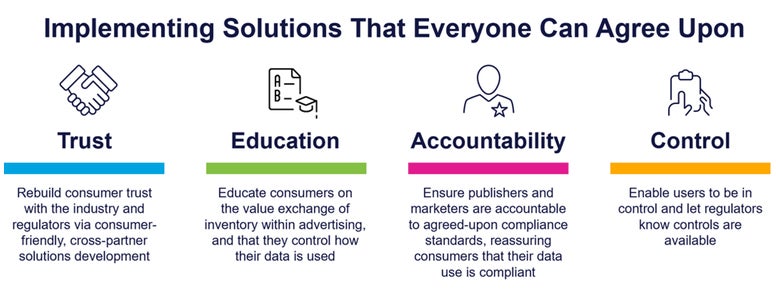“The Sell Sider” is a column written by the sell side of the digital media community.
Today’s column is written by Jason White, global publisher and tech strategy at Prohaska Consulting.
Before I get to anything related to our industry, I hope that you and your families are safe and healthy, as we get through this global COVID-19 pandemic together.
Many of us in our industry remember a quote from around 1998 that went something like, “If you are a CEO for a large corporation and don’t have a website business plan on your desk, you should be fired.”
This was during the first shift from analog to digital, which happened relatively quickly. The dot-com boom had begun, and though a few years later there would be many busts, many of the most innovative businesses emerged soon after, laying the foundation for our new digital future. Moore’s Law, inevitably, helped these companies become the new blue chips of the next 10 to 20-plus years.
Today, we are faced with a similar dramatic industry shift, which we have called a global identity crisis, but there is also an opportunity for a revolution. We are evolving from an unstable, inaccurate, cookie-based world to one of authenticated, first-party audience verification in a new identity world.
All of the browsers are walking away from supporting the cookie in a third-party capacity, and the same can be expected of other current IDs. Google Chrome has given us a two-year window, and state and federal governments are moving toward broad-based regulations that will undoubtedly lean into a more secure first-party engagement with consumers, covering all platforms.
Publishers should become the biggest winners in this new world, since they can, and should be, originating the consumer relationship. But all players in the ecosystem can plan to safely and compliantly acquire, measure and target consumers in this new identity world by focusing on first-party identifiers converting into anonymous IDs.
When I worked at CBS, my plan was to get as many first-party identifiers as possible. I incorporated a soft-wall strategy, where we would enable a soft email or other type of deterministic ID capture with incentivization at each entry point, focused on both web and connected TV (CTV) since we already had the CTV login through streaming video on demand (SVOD).
We partnered with a consent management platform that enabled incentives, such as our SVOD 30-day free trial. Once we acquired the user, we would encrypt the email identifier with identity resolution providers, such as BritePool and LiveRamp. We would then send those IDs to SSPs, which processed and sent them to DSPs, which processed them for advertiser transactions.
When any publisher acquires the consumer identifier in a compliant and safely encrypted way, this ID can be used appropriately for more personal content and marketing and an overall better experience. Other significant benefits come with this process, including improved and more accurate attribution, measurement and site or program optimization.
Imagine what we can now accomplish throughout our ecosystem if we have an addressable, verified first-party identifier across the web. We now know that today’s cookie models would not compare since everything is currently modeled on the assumption that it “probably is that correct person.”
Most of us have many people using multiple screens at our houses every day, so any attempt by advertisers, publishers or vendors to properly model off a device ID, IP address or cookie are inherently flawed, creating wasted time and money and a frustrating user experience. With a first-party identifier, consumers would finally get control of who receives their data.
 So how do we get there? Based on the initial announcements from IAB Tech Lab’s Project Rearc, the feasibility of direct addressability relies on trusted relationships between consumers and valid first parties: brands and publishers. True addressability can only exist with a consumer-provided, consented identifier tied to privacy preferences. Here are proposed next steps for the industry to establish a scalable global infrastructure:
So how do we get there? Based on the initial announcements from IAB Tech Lab’s Project Rearc, the feasibility of direct addressability relies on trusted relationships between consumers and valid first parties: brands and publishers. True addressability can only exist with a consumer-provided, consented identifier tied to privacy preferences. Here are proposed next steps for the industry to establish a scalable global infrastructure:
- Bring together constituents working through all major trade organizations, and collaborate with and receive feedback from brands, agencies, tech and publishers toward one shared solution, to be built by multiple tech firms but trusted through proper cross-industry standard-setting, suitable for all media channels, globally.
- Create a coalition with real liquidity, such as an ad spend commitment from brands and agencies, with inventory from publishers that support tech firms providing appropriate deterministic open web solutions, globally.
- Produce a framework aligning with browser tracking policies and all current and proposed privacy regulations, globally.
- Enable consumers to persist their controls and preferences across every platform, browser, site and device, globally.
- Break through negative perceptions of digital marketing by addressing consumers directly, touting the benefits of personalization, globally.
As long as we keep consumers’ privacy, protection and overall best interests as our primary focus, this revolution should make our new digital ad ecosystem stronger in every way. We are ready to further help unite all constituents to plan for this exciting new identity world to ensure that everyone, globally, not just survives but thrives.
Follow Prohaska Consulting (@TeamProhaska) and AdExchanger (@adexchanger) on Twitter.













